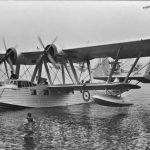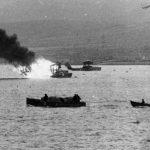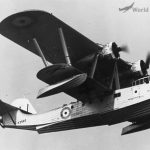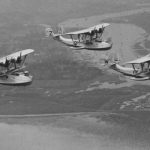K5262 201 Sqn Calshot 1936
L7042 201Sqn bombed at Lerwick 22 November 1939
London Prototype K3560
Saunders Roe London Mk I
London formation 1936
London II K5910 BN-L of No. 240 Squadron RAF
London II TQ-H 202 Squadron RAF
British military biplane flying boat London
London 1936
A flying boat from the Saunders Roe aircraft factory built to British Air Ministry requirements No. R.24/31 for a twin-engine flying boat intended for patrol duties. The first flight of the prototype took place in 1934, followed by a series of operational trials in 209 and 210 Squadrons of the RAF. Ten examples of the first production series, equipped with 820 hp Bristol Pegasus III engines driving twin-blade propellers, were designated London Mk I. The remaining 38 aircraft, named London Mk II, received Bristol Pegasus X engines with 915 hp and four-bladed propellers. In service, the planes of the first series also received more powerful engines and were renamed the Mk II version.
The first copies, delivered between April and September 1936, were received by 201 Squadron RAF, with subsequent copies going to the equipment of 202 and 204 Squadrons. Together with the Supermarine Stranraer aircraft, built to the same requirements, these were the last large biplane flying boats staying in RAF equipment.
Five Saro London aircraft from 204 Squadron took part in a long-haul flight to New South Wales (Australia) between December 1937 and May 1938 to commemorate the 150th anniversary of the founding of the Sydney colony. For this purpose, they were specially equipped with additional external fuel tanks, increasing the flight range to 4184 km.
At the outbreak of World War II, 29 examples of the Londons were still in service, in squadrons 201 in Shetland, 202 in Gibraltar and 240, stationed in northern Scotland (the latter received its aircraft only in June 1939). They were on active patrol duty in the North and Mediterranean seas. The Saro London flying boats were withdrawn from RAF service in early 1941, replaced by Short Sunderland and Consolidated Catalina aircraft. A few copies were transferred to the RCAF.








